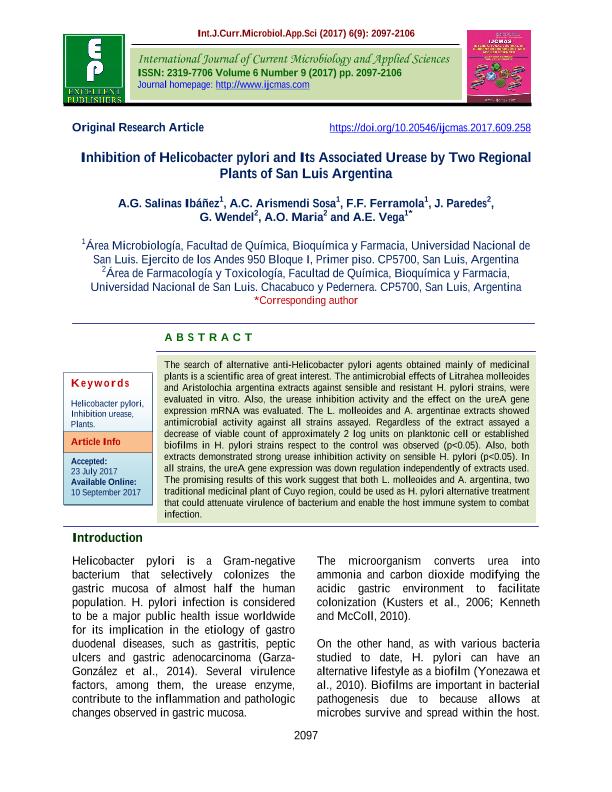Artículo
Inhibition of helicobacter pylori and its associated urease by two regional plants of San Luis Argentina
Salinas Ibañez, Angel Gabriel ; Arismendi Sosa, Andrea Celeste
; Arismendi Sosa, Andrea Celeste ; Ferramola, Florencia Fátima
; Ferramola, Florencia Fátima ; Paredes, Jesica Daniela; Wendel, Graciela Haydée; María, Alejandra O.; Vega, Alba Edith
; Paredes, Jesica Daniela; Wendel, Graciela Haydée; María, Alejandra O.; Vega, Alba Edith
 ; Arismendi Sosa, Andrea Celeste
; Arismendi Sosa, Andrea Celeste ; Ferramola, Florencia Fátima
; Ferramola, Florencia Fátima ; Paredes, Jesica Daniela; Wendel, Graciela Haydée; María, Alejandra O.; Vega, Alba Edith
; Paredes, Jesica Daniela; Wendel, Graciela Haydée; María, Alejandra O.; Vega, Alba Edith
Fecha de publicación:
12/2017
Editorial:
Excellent publishers
Revista:
International Journal of Current Microbiology and Applied Sciences
ISSN:
2319-7692
e-ISSN:
2319-7706
Idioma:
Inglés
Tipo de recurso:
Artículo publicado
Clasificación temática:
Resumen
The search of alternative anti-Helicobacter pylori agents obtained mainly of medicinal plants is a scientific area of great interest. The antimicrobial effects of Litrahea molleoides and Aristolochia argentina extracts against sensible and resistant H. pylori strains, were evaluated in vitro. Also, the urease inhibition activity and the effect on the ureA gene expression mRNA was evaluated. The L. molleoides and A. argentinae extracts showed antimicrobial activity against all strains assayed. Regardless of the extract assayed a decrease of viable count of approximately 2 log units on planktonic cell or established biofilms in H. pylori strains respect to the control was observed (p<0.05). Also, both extracts demonstrated strong urease inhibition activity on sensible H. pylori (p<0.05). In all strains, the ureA gene expression was down regulation independently of extracts used. The promising results of this work suggest that both L. molleoides and A. argentina, two traditional medicinal plant of Cuyo region, could be used as H. pylori alternative treatment that could attenuate virulence of bacterium and enable the host immune system to combat infection.
Archivos asociados
Licencia
Identificadores
Colecciones
Articulos(CCT - SAN LUIS)
Articulos de CTRO.CIENTIFICO TECNOL.CONICET - SAN LUIS
Articulos de CTRO.CIENTIFICO TECNOL.CONICET - SAN LUIS
Citación
Salinas Ibañez, Angel Gabriel; Arismendi Sosa, Andrea Celeste; Ferramola, Florencia Fátima; Paredes, Jesica Daniela; Wendel, Graciela Haydée; et al.; Inhibition of helicobacter pylori and its associated urease by two regional plants of San Luis Argentina; Excellent publishers; International Journal of Current Microbiology and Applied Sciences; 6; 9; 12-2017; 2097-2106
Compartir
Altmétricas



